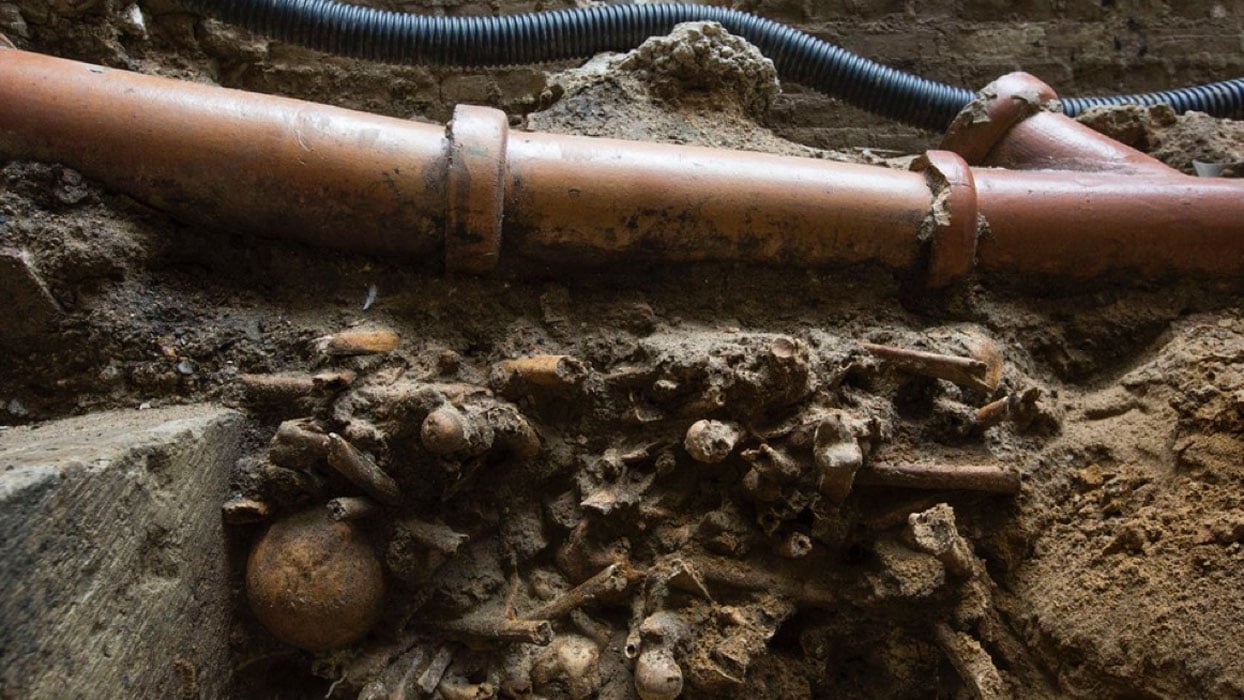Fifty Ancient Skeletons Found Crammed Together under Westminster Abbey Toilet Block
Westminster Abbey, the traditional place of coronation and burial for English monarchs, is one of the most popular historic sites in England. During a recent excavation in the great Abbey, some fifty skeletons were uncovered from the 11 th and 12 th century crammed together beneath a lavatory block. The discovery may provide experts with an insight into the history of medieval England and especially the late Anglo-Saxon and the early Norman periods.
A tower is being built in the abbey to allow visitors to freely access the second floor of the majestic building. According to Mashable the tower is the first to be built at Westminster in 300 years and will give “visitors access to a museum in the attic space’’. The new structure is located not far from the renowned Poet’s Corner, where great writers such as Chaucer are buried. Experts, attached to the abbey were instructed to carry out a survey of the area, before construction begins on the new tower.

Westminster Abbey, London, England (WADII / Fotolia)
A Burial Chamber Beneath a Toilet
The team of archaeologists found the burial chamber after moving a toilet block that was so large and heavy it was likened to a bunker. The discovery was not a total surprise as the excavation team led by Paw Jorgensen knew that there were medieval burials in the location. This was because in the Victorian era, during previous work in the abbey, workmen had found the burials when they were installing a drainage system in the abbey and they had left the remains in place.
Skeletons of the Elite
The experts unearthed some fifty full and partial skeletons. Most of the skulls and bones were piled up in little mounds. One skeleton was found in an impressive stone coffin. While, others according to the Guardian ‘were found still lying in their graves, some carefully lined with chalk blocks’, typical of the 11 th and 12 th century.
The skeletons are those of high-status individuals. This is based on their original burial places in the south transept, which was reserved for those who belonged to the upper-echelons of society. It seemed likely that because of this, many of them were leading prelates and clerics. They were probably moved to their current location during Henry IIIs (1207-1272) reconstruction of the abbey and many of the skulls have holes left by pickaxes, that occurred when they were being disinterred.
- The Voice is Mightier than the Sword: The Stone of Scone That Roared with Power
- Workers Building Parishioners a Toilet Unearth a Mass Anglo-Saxon Grave
- Five Missing Kings and Queens – and Where We Might Find Them

Image from page 168 of “The Roll-Call of Westminster Abbey”, 1906 (Internet Archive Book Images / Flickr)
The archaeologists found the remains of a child who was in a coffin, so it is probably a relative of one of the church nobles. This burial is something of a mystery given that mainly ecclesiastical individuals were buried in the location. However, an abbey archaeologist has stated that “ it is a feature of many ecclesiastical sites that you find the remains of women and children in places where you might not quite expect them” [via The Guardian]. The sex and age of the child has yet to be determined.
The Dead were Disturbed
It is believed that the Victorian workmen who installed the drainage system at the location where the remains had lain for over five hundred years, interfered with the burials. Archaeologists working in the abbey believe that since the burials are mainly those of high-status ecclesiastics, that they were likely interred with valuable grave goods. The team of experts hopes to conduct further investigations to discover whether there any artifacts such as chalices in the burial area.
3,500 People Buried in Westminster Abbey
Histecho website reports that ‘‘the find means 3,500 people are known to have been buried in Westminster Abbey’’. The remains are in good condition and it is expected that scientific tests can provide insights into the health, age and causes of death. This could greatly add to our knowledge of the late Anglo-Saxon period and the early Norman period. An examination of the bones could also provide more information on the early history of the abbey, which is poorly recorded. Once the studies have been completed the remains of those who died almost a millennium ago will be re-interred in a dedicated space within the grounds of the abbey.
Top image: Dozens of skeletons found underneath Westminster Abbey lavatory block. Credit: Dan Kitwood
By Ed Whelan



















